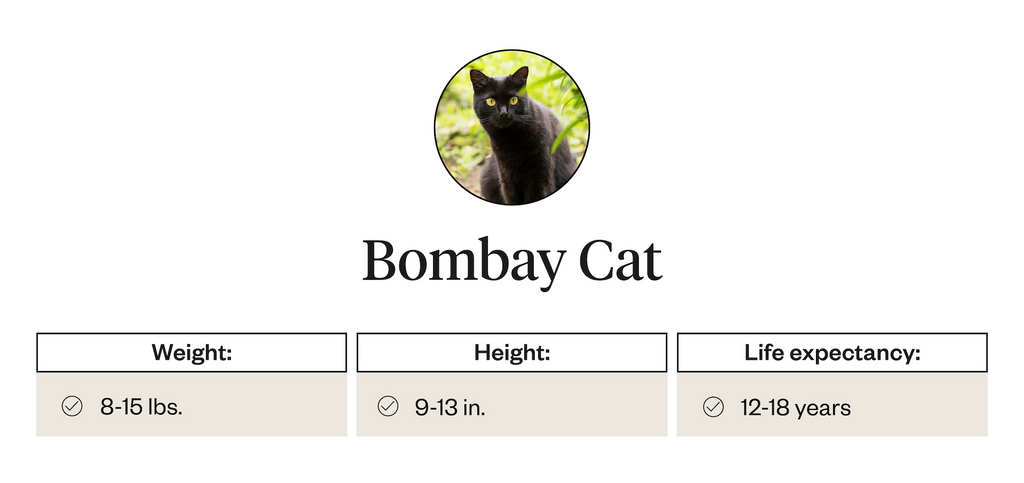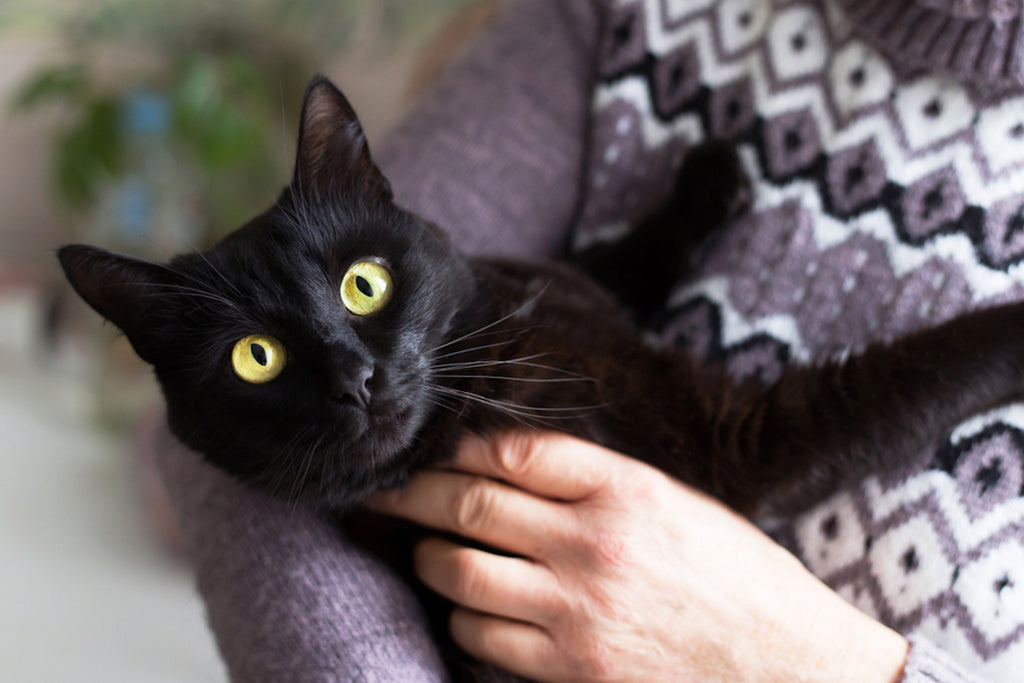7 Min Read
Bombay Cat: Pet Profile
Key takeaway
The Bombay cat is a rare type of feline that’s smart and highly social, making them a great companion for individuals of all ages. This cat requires a standard amount of grooming and care.

Why pet owners are switching to online vet care with Dutch
-
Prescriptions delivered free to you
-
Fast access to Licensed Vets over video
-
Unlimited video visits and follow-ups
The house cat is the most popular pet in the entire world for good reason, and there are more than 600 million cats living among humans globally.1 They’re both aloof and affectionate, savage and serene, active and endearing. As a cat parent, or potential cat parent, you know this all too well, but love your feline and all they bring with them personality-wise.
Below, we’ll look at a very special breed of feline: the Bombay cat.
- History & Origin of Bombay Cats
- Physical Attributes of Bombay Cats
- Behavioral Characteristics of Bombay Cats
- Bombay Cat Health Risks
- Caring for a Bombay Cat
- FAQs
- Bombay: The Panther in Miniature
History & Origin of Bombay Cats
The glossy black Bombay cat, also called the "Black Mamba," was introduced in 1965 by Niki Horner.2 The idea behind their breed development was to create a cat that mimicked the appearance of a miniature panther. Her inspiration came from the fictional cat, Bagheera, in the Jungle Book story.
American shorthair and Burmese cats were coupled to achieve this unique look until there was a successful combination; a jet-black, muscular cat called the Bombay. Interestingly, Bombay was chosen by the breeder because she was hoping to create a new type of cat that mimicked the leopards from Bombay, India.
The Bombay was accepted by the International Cat Association in 1979 and was given championship status by the Cat Fanciers' Association in 1976.3 Today’s Bombay cats allow for crossbreeding with either black American shorthairs or sable Burmese. It's still considered a rare breed by the International Cat Association.
While it's assumed that cats originated with the Egyptians, at least in terms of domestication and companionship, more recent genetic testing has altered those findings. In reality, experts believe that the domestication of cats took place in several different locations.4 Regardless of their origin as a companion species, today’s cats, and Bombays in particular, are worth learning about.

Physical Attributes of Bombay Cats
The physical attribute of the Bombay can be best described as a miniature panther. The Bombay is considered a medium-sized cat with a muscular build. They have a round head, and the tips of their ears, feet, chin, and eyes are also rounded. Their weight ranges from as small as 8 pounds to as heavy as 15 pounds. Males tend to weigh more than 12 pounds, while females typically weigh between 8 and 12 pounds.5
The eye color of the Bombay is either gold or copper when bred from the American species, while the British version of the breed tends to have green eyes.
Their coat is short, black, and glossy, and they don’t shed much, so they're not very demanding in terms of grooming. When the Bombay is properly cared for, their coat is so deep black that it looks like patent leather. Sometimes, Bombay kittens will be born white, but that color won't last, and their coats will darken as they grow older.5
The life expectancy of this unique breed is between 12 and 18 years.2 When picking up a Bombay, they'll feel heavier than they appear as they are muscular.

Behavioral Characteristics of Bombay Cats
The Bombay is unique for various reasons, one of which is its walk, which gives the appearance of a panther or leopard swaying side to side. This walk is similar to the walk of the Indian black leopard.
Bombays tend to be mischievous and personable and seem to find ways to entertain themselves. They're usually friendly, intelligent, outgoing, and vocal, though each animal is unique in its personality and overall makeup. In general, the Bombay cat will fit in well with other pets, family, and friends, making it an excellent addition to any household.
The characteristics of the Bombay breed make sense when their origin is considered. They exhibit the laid-back nature of the American shorthair and the Burmese's social makeup and curiosity. They're generally a people-oriented breed, and owners will say they often spend most of their time underfoot or on a lap.5
Again, each individual cat is unique and will have its own personality, but Bombays will often enjoy interactive games like fetch and are usually pretty playful.5
Bombay Cat Health Risks
As mentioned, Bombays have a typical lifespan, ranging from 12 to 18 years, with some cats living up to 20 years. There are no specific genetic concerns with this breed. However, due to their short muzzle and nose, they tend to experience respiratory problems, runny noses, and other sinus issues.2 They can also develop Hypertrophic Cardiomyopathy. This means the cat’s heart isn't working as efficiently as it should, which can cause additional health complications.
Of course, Bombays can also have health issues when they're overweight. With such a small animal, even a few extra ounces on its frame can have a significant impact. An overweight cat can experience mobility issues and encounter challenges while grooming. Carrying excess weight can also increase their risk for heart disease, diabetes, and cancer.
In addition, as they age and enter their senior years, Bombays can develop issues with their pancreas or kidneys.

Caring for a Bombay Cat
Caring for a Bombay cat is often a joyful experience. Before adopting a Bombay, potential pet parents should consider their characteristics and social needs. In other words, while there might be some exceptions, Bombays are often social creatures that require interaction to thrive and be their most healthy. Therefore, one of the most essential parts of caring for a Bombay cat is simply being present and interacting with them.
Thankfully, grooming a Bombay is easy since they don't shed excessively.5 However, they're not considered a hypoallergenic breed and require brushing around once a week. Their ears don't need a lot of upkeep either and should be cleaned as needed. Don’t use a cotton swab for cleaning their ears; instead, use a cotton ball or soft towel.
Teeth and nails also need to be regularly groomed. The earlier a pet parent begins this habit of teeth brushing and grooming, the easier it will be to keep up the maintenance, and the less the cat will fight against it. A cat’s teeth should be brushed weekly to ensure tooth health, prevent plaque buildup and reduce the risk of dental or periodontal issues.
A Bombay's nails should be trimmed regularly–at least every other week. To further help groom a cat’s nails, scratching posts or cat toys designed for scratching can wear down the nails and reduce the maintenance required.
When it comes to feeding, Bombay owners have to be diligent as the breed can become eager about their food and overeat, resulting in obesity. Measuring the cat’s food and sticking to a specific feeding schedule can help reduce the risk of overfeeding and overeating.
Also, it’s important to keep the Bombay inside at all times since they're naturally curious and can contract diseases outdoors. Due to their curiosity and social nature, they also tend to run away more often or get into altercations with other animals.
FAQs
Are Bombay cats rare?
Yes. The Bombay breed is a domesticated cat with copper eyes and a slick black coat, resembling a black panther. While there are many black cats to be found, most are not the Bombay breed since this is a rarer mixture of bloodlines. There are only a handful of breeders in the United States, and most pet parents have to wait six to 12 months on a waitlist to get a Bombay kitten.
What is the difference between a Bombay cat vs. black cat?
All Bombays are black cats, but not every black cat is a Bombay. Many different types of felines have black coats, so black cats can look similar to a Bombay. However, the genetic makeup, combination of bloodlines, and unique characteristics of the Bombay are theirs alone.
Are Bombay cats good house cats?
Yes. Overall, Bombays are good house cats. They're generally good with kids, social, intelligent, and outgoing. However, they tend to be a bit dominating as well. They shouldn't be left without stimulation for long periods. They need interaction with humans.
Bombay: The Panther in Miniature
The beautiful Bombay is a unique-looking breed that exhibits grace and intellect and is generally good with all age groups. This cat doesn’t require a lot of grooming, isn’t overly prone to health issues, and is considered a good addition to a wide variety of homes and families.
When considering a Bombay, it’s good to look into Dutch for all their veterinary needs to keep this special breed healthy and thriving. Through Dutch, pet parents can access preventive medication, nutritional advice, and veterinary care without leaving home. Keeping a Bombay healthy and happy will increase their chances of living a long life full of joy and fulfillment.
Share
References
-
Osborn, Jen Flatt. “How Many Cats Are in the World? A Statistical Overview.” WAF, 29 May 2023, worldanimalfoundation.org/cats/how-many-cats-are-in-the-world/.
-
W, Emily. “Bombay Cat Facts.” ASPCA Pet Health Insurance, 22 Oct. 2020, www.aspcapetinsurance.com/resources/bombay-cat/.
-
“Bombay at a Glance.” TICA, www.tica.org/breeds/browse-all-breeds?view=article&id=2079. Accessed 2 Aug. 2023.
-
“How Did Cats Become Domesticated?” The Library of Congress, www.loc.gov/everyday-mysteries/zoology/item/how-did-cats-become-domesticated/. Accessed 1 Aug. 2023.
-
“Bombay Cat Breed Information.” Purina, www.purina.co.uk/find-a-pet/cat-breeds/bombay. Accessed 1 Aug. 2023.



